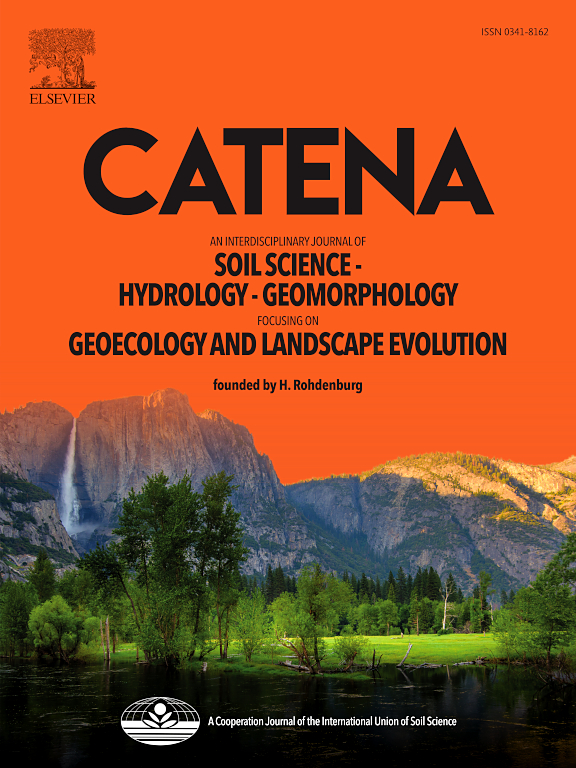碳饱和水平调节森林土壤矿物伴生有机碳的稳定性
IF 5.7
1区 农林科学
Q1 GEOSCIENCES, MULTIDISCIPLINARY
引用次数: 0
摘要
矿物伴生有机碳(MAOC)的稳定性是土壤有机碳(SOC)长期保存的关键决定因素,主要受矿物-有机结合相互作用的支配。然而,矿物组成和初始碳饱和水平(CSL)对MAOC稳定性的调节机制尚不清楚。在本研究中,我们选择了中国3个气候带的6种森林土壤,通过过氧化氢(H2O2)模拟微生物氧化降解来研究MAOC的化学稳定性。结果表明:土壤有机碳中,MAOC占40.84 ~ 86.93%,其空间分布受伊利石含量和比表面积的影响;处理后的剩余MAOC (r-MAOC)占MAOC的25.32 ~ 86.66%,抗氧化效率与CSL和粘土含量显著相关。在氧化过程中,mac优先损失了大量植物源性有机碳,与羟基碳等矿物表面结合相对较弱(1.43-22.10%),而微生物源性多糖碳显著增加(0.48-19.64%)。在不饱和条件下,较高的CSL水平对应于更高的MAOC稳定性,这意味着有机物优先与空矿物位点结合并稳定。偏最小二乘路径模型(PLS-PM)和随机森林模型(RFM)分析表明,土壤水分和矿物组成是影响mac稳定性的关键因素(分别为0.79和0.41)。该研究为预测森林土壤碳稳定性提供了理论见解,并有助于通过细化MAOC动态来改进全球碳循环模型。本文章由计算机程序翻译,如有差异,请以英文原文为准。
Carbon saturation level regulates the stability of mineral-associated organic carbon in forest soils
The stability of mineral-associated organic carbon (MAOC) serves as a critical determinant of long-term soil organic carbon (SOC) preservation, predominantly governed by mineral-organic binding interactions. However, the regulatory mechanisms of mineral composition and initial carbon saturation level (CSL) on MAOC stability remain poorly understood. In this study, we selected six forest soils from three climatic zones in China, and simulated microbial oxidative degradation using hydrogen peroxide (H2O2) to investigate MAOC chemical stability. The results showed that MAOC contributed 40.84–86.93% of SOC, with spatial variation influenced by the illite content and specific surface area. The remaining MAOC (r-MAOC) after treatment accounted for 25.32–86.66% of MAOC and the oxidation-resistant efficiency was significantly correlated with CSL and clay content. During oxidation MAOC preferentially lost a high proportion of plant-derived organic carbon with relatively weak binding to the mineral surfaces like hydroxyl carbon (1.43–22.10%), while microbial-derived polysaccharide carbon significantly increased by 0.48–19.64%. Under unsaturated conditions, higher CSL levels corresponds with increased MAOC stability, implying that organic matter preferentially binds to and stabilizes on vacant mineral sites. The partial least squares path model (PLS-PM) and random forest model (RFM) analysis indicated that CSL and mineral composition were key determinants of MAOC stability (0.79 and 0.41). This study provides theoretical insights into predicting forest soil carbon stability and contributes to improving global carbon cycle modeling by refining MAOC dynamics.
求助全文
通过发布文献求助,成功后即可免费获取论文全文。
去求助
来源期刊

Catena
环境科学-地球科学综合
CiteScore
10.50
自引率
9.70%
发文量
816
审稿时长
54 days
期刊介绍:
Catena publishes papers describing original field and laboratory investigations and reviews on geoecology and landscape evolution with emphasis on interdisciplinary aspects of soil science, hydrology and geomorphology. It aims to disseminate new knowledge and foster better understanding of the physical environment, of evolutionary sequences that have resulted in past and current landscapes, and of the natural processes that are likely to determine the fate of our terrestrial environment.
Papers within any one of the above topics are welcome provided they are of sufficiently wide interest and relevance.
 求助内容:
求助内容: 应助结果提醒方式:
应助结果提醒方式:


